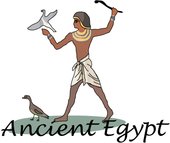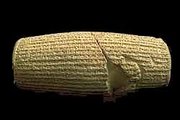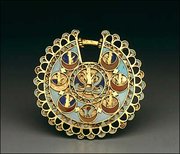Achaemenid dynasty
|
|
The Achaemenid Dynasty (Hakamanishiya in the Avestan language, هخامنشی - transliterated Hakamanshee in Modern Persian) was a dynasty in the ancient Persian Empire, including Cyrus II the Great, Darius the Great and Xerxes I. At the height of their power, the Achaemenid rulers of Persia ruled over territories roughly encompassing some parts of today's Iran, Iraq, Turkey, Bulgaria, Greece, Egypt, Syria, Pakistan, Jordan, Israel, Lebanon, Caucasia, Central Asia, Arabia and Lybia.
At different times, the Achaemenids also ruled Egypt, although the Egyptians twice regained their independence from Persia. After the practice of Manetho, Egyptian historians refer to the period in Egypt when the Achaemenid dynasty ruled as the Twenty-seventh (525 BC - 404 BC) and Thirty-first Dynasties (343- 332 BC).
The last Achaemenid king was Darius III (336 BC - 330 BC), who was defeated by Alexander III of Macedon. After the Macedonian conquest, the Persian Empire was annexed by Alexander.
| Contents |
History
The founder of this dynasty was supposedly Achaemenes (Old Persian Haxāmaniš "Of Friendly Mind"). He was succeeded by his son Teispes (Cišpi), who first took the title King of Anšān after seizing that city from the Elamites. Inscriptions indicate that when Teispes died, two of his sons shared the throne as Cyrus I (Kūru), king of Anšān, and Ariaramnes (Ariyāramna "Having the Iranians at Peace"), king of Parsua (later called Pārsa "Persia", hence Fārsi, the native name for modern Persian). They were succeeded by their respective sons Cambyses I of Anshan (Kambūjiya, "the Elder"), and Arsames (Aršāma "Having a Hero's Might") of Persia.
In 559 BC, Cambyses I the Elder was succeeded as king of Anšān by his son Cyrus II the Great, who also succeeded the still-living Arsames as King of Persia, thus reuniting the two realms. Cyrus II is considered to be the first king of the Achaemenid dynasty to be properly called so, as his predecessors were subservient to Media. Cyrus II conquered Media, Lydia and Babylon.
His successors were less successful. Cyrus' unstable son Cambyses II conquered Egypt, but died in July 522 BC as the result of either accident or suicide, during a revolt led by a priest, Gaumata. Gaumata usurped the throne by pretending to be Smerdis (Pers. Bardiya; Cambyses' brother whom he had secretly had assassinated in 525, before starting out for his Egyptian campaign) until he was overthrown in 522 BC by a member of a lateral branch of the Achaemenid family, Darius I (Old Persian Dārayawuš "Who Holds Firm the Good", also known as Darayarahush or Darius the Great).
According to Herodotus, the native leadership then debated the best form of government for the Empire. He reports that it was decided that oligarchy would divide them against one another, and democracy would bring about mob rule resulting in a charismatic leader resuming the monarchy. Therefore, they decided a new monarch was in order, particularly since they were in a position to choose him. Darius I was chosen monarch from amongst the leaders. He was cousin to Cambyses II and Smerdis, claiming Ariaramnes as his ancestor.
Darius attacked the Greek mainland, that had supported rebellious Greek colonies under his aegis; but as a result of his defeat at the Battle of Marathon in 490, he was forced to retract the limits of the empire to Asia Minor.
The Achaemenids thereafter consolidated areas firmly under their control. It was Cyrus and Darius who, by sound and farsighted administrative planning, brilliant military maneuvering, and a humanistic worldview, established the greatness of the Achaemenids and in less than thirty years raised them from an obscure tribe to a world power.
The zenith of Achaemenid power was achieved during his reign (521 BC-485 BC) and that of his son Xerxes I (485 BC - 465 BC, Old Persian Xšāyaršā "Hero Among Kings"). These two rulers built great, beautiful palaces in the ancient cities of Persepolis, Susa and Ecbatana (Hagmatāna "City of Gatherings"). The Persian Empire reached its greatest extent in this period.
Decline
After the death of Xerxes I (465 BC), the decline of the dynasty began. Persia saw a sequence of weak rulers ruling the empire. Decadence became rampant, and the army, finance and government administration were neglected. The last Achaemenid king was Darius III (336 BC - 330 BC), who was defeated by Alexander III of Macedon. After the Macedonian conquest, the Persian Empire was annexed by Alexander.
System of governing
The Achaemenids were enlightened despots who allowed a certain amount of regional autonomy in the form of the satrapy system. A satrapy was an administrative unit, usually organized on a geographical basis. A satrap (governor) administered the region, a general supervised military recruitment and ensured order, and a state secretary kept official records. The general and the state secretary reported directly to the central government. The twenty satrapies were linked by a 2,500-kilometer highway, the most impressive stretch being the royal road from Susa to Sardis, built by command of Darius. Relays of mounted couriers could reach the remotest of areas in fifteen days. Despite the relative local independence afforded by the satrapy system however, royal inspectors, the "eyes and ears of the king," toured the empire and reported on local conditions, and the king maintained a personal bodyguard of 10,000 men, called the Immortals.
The language in greatest use in the empire was Aramaic. Old Persian was the "official language" of the empire, but was used only for inscriptions and royal proclamations.
Darius revolutionized the economy by placing it on a silver and gold coinage system. Trade was extensive, and under the Achaemenids there was an efficient infrastructure that facilitated the exchange of commodities among the far reaches of the empire. As a result of this commercial activity, Persian words for typical items of trade became prevalent throughout the Middle East and eventually entered the English language; examples are bazaar, shawl, sash, turquoise, tiara, orange, lemon, melon, peach, spinach, and asparagus. Trade was one of the empire's main sources of revenue, along with agriculture and tribute. Other accomplishments of Darius' reign included codification of the data, a universal legal system upon which much of later Iranian law would be based, and construction of a new capital at Persepolis, where vassal states would offer their yearly tribute at the festival celebrating the spring equinox.
Contributions
The Achaemenids should be noted for their most important contribution to the world: the first declaration of human rights. This declaration was called the Cyrus Charter of Human Rights. Cyrus the Great, son of the founder of the dynasty, fought the Babylonians, eventually taking over and giving the Jews the freedom to practice their religion.
The religion of the Achaemenids was Zoroastrianism, whose adherents at the time were noted for their dedication to clear lines of right and wrong, and for their apparent honesty.
Cyrus' political behaviour was also attributed to his being shrewd - appearing as the "saviour" of a nation virtually guaranteed of their allegiance and well-disposed behaviour. It was the general policy of the Achaemenids to continue the Assyrian and Babylonian policy of transferring large populations between areas, in effect mixing disparate groups together and diluting any nationalism they may otherwise have had - intended as a calming measure, and resulting in the Achaemenid era (ca. 650-330 BC) being known as a relatively peaceful period in Middle Eastern history.
Art
Achaemenid art, like Achaemenid religion, was a blend of many elements. Just as the Achaemenids were tolerant in matters of local government and custom, as long as Persians controlled the general policy and administration of the empire, so also were they tolerant in art so long as the finished and total effect was Persian. At Pasargadae, the capital of Cyrus the Great and Cambyses in Fars, the Persian homeland, and at Persepolis, the neighbouring city founded by Darius the Great and used by all of his successors, one can trace to a foreign origin almost all of the several details in the construction and embellishment of the architecture and the sculptured reliefs; but the conception, planning, and overall finished product are distinctly Persian and could not have been created by any of the foreign groups who supplied the king of kings with artistic talent.
Cyrus may have been the leader of Persian tribes not yet so sophisticated nor so civilized as the Babylonians or Egyptians, but when he chose to build Pasargadae, he had a long artistic tradition behind him that was probably already distinctly Iranian and that was in many ways the equal of any. Two examples suffice: the tradition of the columned hall in architecture and fine gold work. The former can now be seen as belonging to an architectural tradition on the Iranian Plateau that extended back through the Median period to at least the beginning of the 1st millennium BC. The rich Achaemenid gold work, which inscriptions suggest may have been a specialty of the Medes, was in the tradition of the delicate metalwork found in Iron Age II times at Hasanlu and still earlier at Marlik.
This Achaemenid artistic style is evident in the iconography of Persepolis, which celebrates the king and the office of the monarch. In its carefully proportioned and well-organized ground plan, rich architectural ornament, and magnificent decorative reliefs, Persepolis, primarily the creation of Darius and Xerxes, is one of the great artistic legacies of the ancient world.
In its art and architecture, Persepolis reflected Darius' perception of himself as the leader of a conglomerate people to whom he had given a new and single identity. The Achaemenid art and architecture found there is at once distinctive and highly eclectic. The Achaemenids took the art forms and the cultural and religious traditions of many of the ancient Middle Eastern peoples and combined them into a single form.
In describing, with justifiable pride, the construction of his palace at Susa, Darius says,
- The cedar timber (a mountain by name Lebanon) from there it was brought the yaka timber was brought from Gandara and from Carmania. The gold was brought from Sardis and from Bactria . . . the precious stone lapis-lazuli and carnelian . . . was brought from Sogdiana. The turquoise from Chorasmia The silver and ebony from Egypt the ornamentation from Ionia the ivory from Ethiopia and from Sind and from Arachosia The stone-cutters who wrought the stone, those were Ionians and Sardians. The goldsmiths were Medes and Egyptians. The men who wrought the wood, those were Sardians and Egyptians. The men who wrought the baked brick, those were Babylonians. The men who adorned the wall, those were Medes and Egyptians.
This was an imperial art on a scale the world had not seen before. Materials and artists were drawn from all the lands ruled by the Great King, and thus tastes, styles, and motifs became mixed together in an eclectic art and architecture that in itself mirrored the empire and the Persians' understanding of how that empire ought to function. Yet the whole was entirely Persian.
So also with the small arts where the Persians excelled: fine metal tableware, jewelry, seal cutting, weaponry and its decoration, and pottery. It has been suggested that the Persians called upon the subject peoples for artists because they were themselves crude barbarians with little taste, and needed quickly to create an imperial art to match their sudden rise to political power. Yet excavations at sites from the protohistoric period show this not to have been the case.
Achaemenid rulers
- Achaemenes of Persia.†
- Teispes of Anshan, his son.
- Cyrus I of Anshan, his son.
- Ariaramnes of Persia,† son of Teispes and co-ruler with Cyrus I.
- Cambyses I of Anshan, son of Cyrus I.
- Arsames of Persia,† son of Ariaramnes and co-ruler with Cambyses I
- Cyrus II the Great, son of Cambyses I, ruled from c.550 - 530 BC.
- Cambyses II, his son, ruled 530 - 521 BC.
- Smerdis, his alleged brother, ruled 521 BC
- Darius I, his brother-in-law and grandson of Arsames, ruled 521 -486 BC.
- Xerxes I, his son, ruled 486 -465 BC
- Artaxerxes I, his son, ruled 464 - 424 BC.
- Xerxes II, his son, ruled 424 - 423 BC.
- Sogdianus, his half-brother and rival, ruled 424 - 423 BC.
- Darius II, his half-brother and rival, ruled 424 - 404 BC.
- Artaxerxes II, his son, ruled 404 - 358 BC (see also Xenophon).
- Artaxerxes III,his son, ruled 358 - 338 BC
- Arses, his son, ruled 338 - 336 BC
- Darius III Codomannus, great-grandson of Darius II, ruled 336 -330 BC
†The epigraphic evidence for these rulers is highly suspect, and often considered to have been invented by Darius I.
Ancient Egypt Clipart and Pictures
- Ancient Egypt Architecture (http://classroomclipart.com/cgi-bin/kids/imageFolio.cgi?direct=History/Ancient_Civilizations/Ancient_Egypt/Architecture)
- Ancient Egypt Art (http://classroomclipart.com/cgi-bin/kids/imageFolio.cgi?direct=History/Ancient_Civilizations/Ancient_Egypt/Art)
- Ancient Egypt Clipart (http://classroomclipart.com/cgi-bin/kids/imageFolio.cgi?direct=History/Ancient_Civilizations/Ancient_Egypt/Clipart)
- Ancient Egypt Clothing (http://classroomclipart.com/cgi-bin/kids/imageFolio.cgi?direct=History/Ancient_Civilizations/Ancient_Egypt/Clothing)
- Ancient Egypt Architecture (http://classroomclipart.com/cgi-bin/kids/imageFolio.cgi?direct=History/Ancient_Civilizations/Ancient_Egypt/Commerce)
- Ancient Egypt Daily Life (http://classroomclipart.com/cgi-bin/kids/imageFolio.cgi?direct=History/Ancient_Civilizations/Ancient_Egypt/Daily_Life)
- Ancient Egypt Games and Toys (http://classroomclipart.com/cgi-bin/kids/imageFolio.cgi?direct=History/Ancient_Civilizations/Ancient_Egypt/Games_and_Toys)
- Ancient Egypt Hieroglyphs (http://classroomclipart.com/cgi-bin/kids/imageFolio.cgi?direct=History/Ancient_Civilizations/Ancient_Egypt/Hieroglyphs)
- Ancient Egypt People (http://classroomclipart.com/cgi-bin/kids/imageFolio.cgi?direct=History/Ancient_Civilizations/Ancient_Egypt/Historical_People)
- Ancient Egypt Illustrations (http://classroomclipart.com/cgi-bin/kids/imageFolio.cgi?direct=History/Ancient_Civilizations/Ancient_Egypt/Illustrations)
- Ancient Egypt Mummies (http://classroomclipart.com/cgi-bin/kids/imageFolio.cgi?direct=History/Ancient_Civilizations/Ancient_Egypt/Mummies)
- Ancient Egypt Musical Instruments (http://classroomclipart.com/cgi-bin/kids/imageFolio.cgi?direct=History/Ancient_Civilizations/Ancient_Egypt/Musical_Instruments)
- Ancient Egypt Pyramids (http://classroomclipart.com/cgi-bin/kids/imageFolio.cgi?direct=History/Ancient_Civilizations/Ancient_Egypt/Pyramids)
- Ancient Egypt Religion (http://classroomclipart.com/cgi-bin/kids/imageFolio.cgi?direct=History/Ancient_Civilizations/Ancient_Egypt/Religion)
- Ancient Egypt Statues (http://classroomclipart.com/cgi-bin/kids/imageFolio.cgi?direct=History/Ancient_Civilizations/Ancient_Egypt/Statues)
- Ancient Egypt Temples (http://classroomclipart.com/cgi-bin/kids/imageFolio.cgi?direct=History/Ancient_Civilizations/Ancient_Egypt/Temples)
- Ancient Egypt Transportation (http://classroomclipart.com/cgi-bin/kids/imageFolio.cgi?direct=History/Ancient_Civilizations/Ancient_Egypt/Transportation)
- Ancient War and Armies (http://classroomclipart.com/cgi-bin/kids/imageFolio.cgi?direct=History/Ancient_Civilizations/Ancient_Egypt/War_and_Armies)



